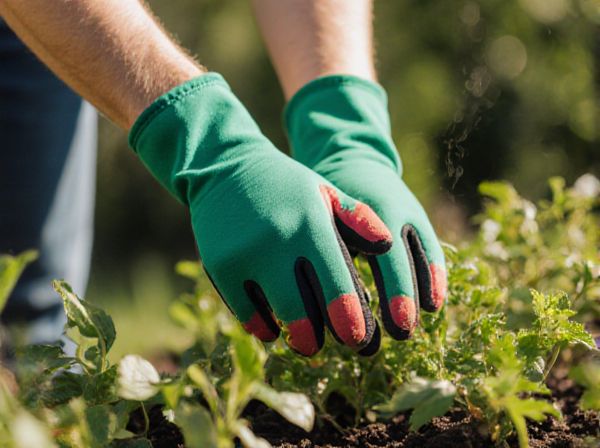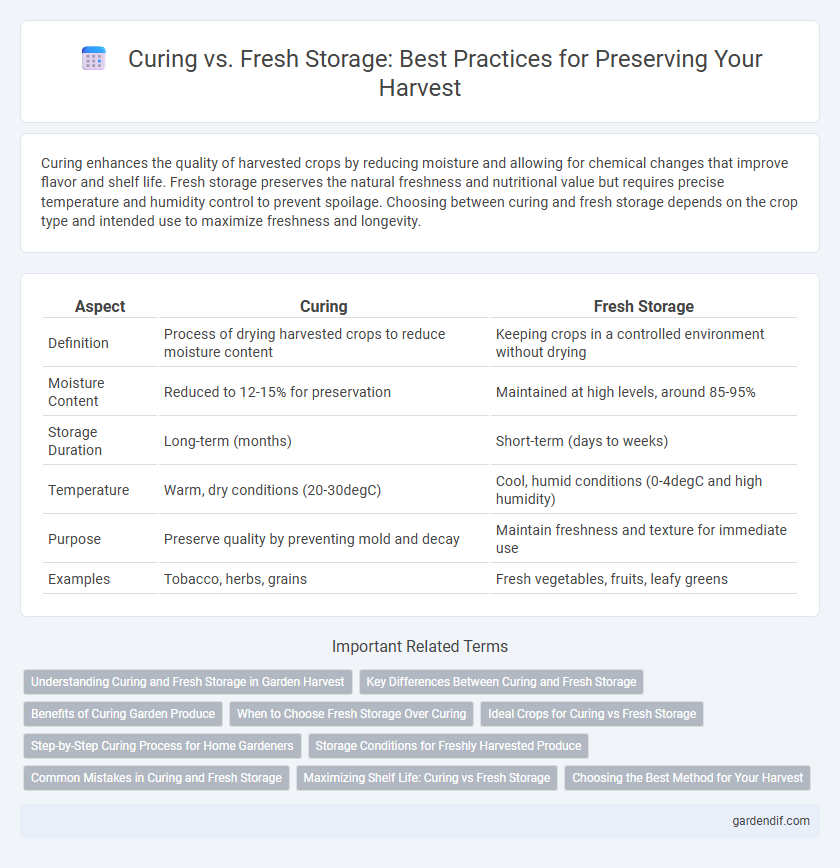
Curing vs Fresh Storage Illustration
Curing enhances the quality of harvested crops by reducing moisture and allowing for chemical changes that improve flavor and shelf life. Fresh storage preserves the natural freshness and nutritional value but requires precise temperature and humidity control to prevent spoilage. Choosing between curing and fresh storage depends on the crop type and intended use to maximize freshness and longevity.
Table of Comparison
| Aspect | Curing | Fresh Storage |
|---|---|---|
| Definition | Process of drying harvested crops to reduce moisture content | Keeping crops in a controlled environment without drying |
| Moisture Content | Reduced to 12-15% for preservation | Maintained at high levels, around 85-95% |
| Storage Duration | Long-term (months) | Short-term (days to weeks) |
| Temperature | Warm, dry conditions (20-30degC) | Cool, humid conditions (0-4degC and high humidity) |
| Purpose | Preserve quality by preventing mold and decay | Maintain freshness and texture for immediate use |
| Examples | Tobacco, herbs, grains | Fresh vegetables, fruits, leafy greens |
Understanding Curing and Fresh Storage in Garden Harvest
Curing enhances the flavor, texture, and shelf life of harvested crops by allowing them to dry and stabilize under controlled conditions, reducing moisture content and preventing mold growth. Fresh storage, in contrast, involves keeping harvested produce in cool, humid environments to maintain freshness and slow down spoilage without drying. Understanding the differences between curing and fresh storage is essential for optimizing garden harvest preservation and extending the usability of fruits and vegetables.
Key Differences Between Curing and Fresh Storage
Curing involves controlled drying and aging to enhance flavor, texture, and shelf life by reducing moisture content, whereas fresh storage prioritizes maintaining optimal humidity and temperature to preserve the produce's natural freshness and prevent spoilage. Key differences include curing's reliance on airflow and extended time to develop desired chemical changes, while fresh storage limits exposure to oxygen and slows metabolic processes for immediate consumption. Curing is essential for crops like garlic and onions, while fresh storage suits leafy greens and berries needing rapid turnover.
Benefits of Curing Garden Produce
Curing garden produce enhances shelf life by reducing moisture content and promoting the formation of protective skins, which resist decay and microbial growth. This process improves flavor and texture, allowing root vegetables like potatoes, onions, and garlic to develop richer taste profiles. Curing also minimizes spoilage during extended storage, making it ideal for preserving harvests over several months.
When to Choose Fresh Storage Over Curing
Fresh storage is ideal when immediate consumption is planned or the produce has a high moisture content that may spoil during curing. Choose fresh storage for crops like leafy greens and berries that retain flavor and texture best when refrigerated shortly after harvest. Avoid curing for delicate items that require minimal handling and quick turnover to maintain optimal freshness and nutritional value.
Ideal Crops for Curing vs Fresh Storage
Root vegetables such as potatoes, carrots, and beets are ideal for curing, as the process enhances their flavor and extends shelf life by reducing moisture and toughening skins. Leafy greens and soft fruits like lettuce, spinach, and berries are best suited for fresh storage due to their high water content and delicate textures that degrade quickly when cured. Understanding the specific physiological needs of each crop type ensures optimal post-harvest quality and prolonged edibility.
Step-by-Step Curing Process for Home Gardeners
Curing harvested crops involves controlled drying and aging to enhance flavor and preserve quality, contrasting with fresh storage, which emphasizes immediate cold and humidity control to retain crispness. For home gardeners, the step-by-step curing process begins with gently cleaning the produce, followed by drying in a warm, well-ventilated area for several days until the outer skin is tough. Once dried, store the crops in a cool, dark environment with moderate humidity to complete the curing phase and extend shelf life.
Storage Conditions for Freshly Harvested Produce
Storage conditions for freshly harvested produce critically influence shelf life and quality preservation. Maintaining optimal temperature, humidity, and ventilation prevents moisture loss and microbial growth, thereby prolonging freshness and nutritional value. Properly controlled environments, such as refrigerated storage at 0-4degC with 85-95% relative humidity, are essential to minimize enzymatic activity and respiration rates in fruits and vegetables.
Common Mistakes in Curing and Fresh Storage
Common mistakes in curing include improper humidity levels and insufficient airflow, which can lead to mold growth and uneven drying. In fresh storage, failing to maintain consistent cool temperatures and high humidity causes premature spoilage and loss of quality. Avoiding these errors ensures optimal preservation and extends the shelf life of harvested crops.
Maximizing Shelf Life: Curing vs Fresh Storage
Curing enhances shelf life by reducing moisture content and preventing microbial growth, which is critical for root vegetables like carrots and potatoes. Fresh storage maintains produce at optimal low temperatures with high humidity to slow down respiration and delay spoilage but offers a shorter duration compared to cured products. Choosing curing or fresh storage depends on the specific crop and desired storage period to maximize quality and minimize losses effectively.
Choosing the Best Method for Your Harvest
Choosing the best method for your harvest depends on the crop type, moisture content, and intended use to maximize quality and shelf life. Curing enhances flavor and durability by allowing proper drying and chemical changes, ideal for crops like tobacco, garlic, and onions. Fresh storage maintains moisture and nutrients for items like leafy greens and berries but requires precise temperature and humidity control to prevent spoilage.
Curing vs Fresh Storage Infographic

 gardendif.com
gardendif.com